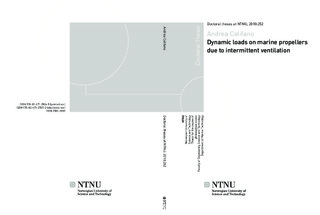| dc.contributor.author | Califano, Andrea | nb_NO |
| dc.date.accessioned | 2014-12-19T12:06:18Z | |
| dc.date.available | 2014-12-19T12:06:18Z | |
| dc.date.created | 2011-01-06 | nb_NO |
| dc.date.issued | 2010 | nb_NO |
| dc.identifier | 383862 | nb_NO |
| dc.identifier.isbn | 978-82-471-2504-5 (printed ver.) | nb_NO |
| dc.identifier.isbn | 978-82-471-2505-2 (electronic ver.) | nb_NO |
| dc.identifier.uri | http://hdl.handle.net/11250/237867 | |
| dc.description.abstract | Dynamic Positioning (DP) systems are increasingly replacing traditional positionkeeping methods—such as jack-up barges and anchoring systems—on board ships operating in ever deeper waters. During these operations, the combined effect of heavy sea states and high propeller loadings have caused a number of damages on azimuth and tunnel thrusters, causing service downtime and requiring costly repairs. Damages in rough seas were reported also during transit operations. These damages can be caused by dynamic loads on the propeller due to intermittent ventilation. Ventilation occurs on thrusters operating at high loadings and low submergence, experiencing continuous cycles in- and out-of water. This leads to sudden thrust losses and violent impact loads.
The present work aims at modeling the dynamic loads during propeller ventilation, in order to predict the corresponding losses. Model tests and numerical simulations were performed in order to better understand the mechanisms of dynamic forces due to ventilation. Furthermore, numerical simulations carry on the challenge of applying a Volume of Fluid (VOF) method to this type of problem.
The performed model tests have shown two main ventilation mechanisms, depending on the propeller submergence, loading and advance ratio: (i) at deeper submergence through a free-surface vortex and (ii) at moderate submergences through the blade itself piercing the free surface. These two mechanisms can exist separately or at the same time, identifying three distinctive ventilation regimes.
The performed numerical simulations are able to reproduce the main features observed during the experiments: air is drawn from the free-surface and transported along the propeller rotation, for both the ventilation types previously identified. The dynamic loads computed with the numerical model are in satisfactory agreement with the experimental data at the upright position where the blade is piercing the free-surface, whereas thrust is over-estimated at all the other angular positions. Unlike ventilation of surface-piercing propellers with super-cavitating profile, it was found that the tip-vortex has a dominant role in the type of ventilation object of this study.
The tip-vortex was also identified as the most likely factor responsible for the overestimation found in the numerical simulations of the thrust for the angular positions where the blade is deeply submerged. Other causes for the deviation between numerical simulations and experiments are further discussed.
A qualitative model of the dynamic loads occurring during one propeller revolution was derived, based on the impact of the blade with the air entrained by the tip vortex, leading to two main thrust losses: (i) an absolute minimum loss about the angular position of π/4 and (ii) a local minimum loss about 3/2π. | nb_NO |
| dc.language | eng | nb_NO |
| dc.publisher | Norges teknisk-naturvitenskapelige universitet, Fakultet for ingeniørvitenskap og teknologi, Institutt for marin teknikk | nb_NO |
| dc.relation.ispartofseries | Doktoravhandlinger ved NTNU, 1503-8181; 2010:252 | nb_NO |
| dc.title | Dynamic loads on marine propellers due to intermittent ventilation | nb_NO |
| dc.type | Doctoral thesis | nb_NO |
| dc.contributor.department | Norges teknisk-naturvitenskapelige universitet, Fakultet for ingeniørvitenskap og teknologi, Institutt for marin teknikk | nb_NO |
| dc.description.degree | PhD i marin teknikk | nb_NO |
| dc.description.degree | PhD in Marine Technology | en_GB |
